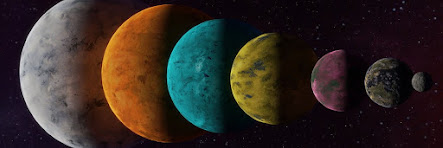- Get link
- X
- Other Apps
- Get link
- X
- Other Apps
The Quest for Other Worlds
Introduction:
Exoplanets, planets that orbit stars outside our solar system, have captured the imagination of astronomers and enthusiasts alike. In this blog post, we embark on a journey to explore the fascinating world of exoplanets, delving into their discovery, diversity, and the tantalizing possibility of finding extraterrestrial life.
The Discovery of Exoplanets
The search for exoplanets began in earnest in the 1990s, with the discovery of the first confirmed exoplanet orbiting a sun-like star, 51 Pegasi b. Since then, astronomers have detected thousands of exoplanets using a variety of detection methods, including the transit method, radial velocity method, and direct imaging.
Types of Exoplanets
Exoplanets come in a wide variety of sizes, compositions, and orbital configurations. From massive gas giants akin to Jupiter to rocky worlds similar to Earth, the diversity of exoplanets is staggering. Some orbit close to their parent stars, where temperatures soar to thousands of degrees Celsius, while others reside in the habitable zone, where conditions may be suitable for liquid water and potentially life as we know it.
Habitable Zone and Goldilocks Planets
The habitable zone, also known as the Goldilocks zone, refers to the region around a star where temperatures are just right for liquid water to exist on the surface of a planet. Planets located within this zone are considered prime candidates in the search for extraterrestrial life, as water is a crucial ingredient for life as we know it.
Kepler Mission and Exoplanet Discoveries
One of the most prolific exoplanet-hunting missions to date is the Kepler Space Telescope. Launched by NASA in 2009, Kepler revolutionized our understanding of exoplanets by surveying a patch of sky and detecting the subtle dimming of stars caused by transiting exoplanets. Over its mission lifetime, Kepler discovered thousands of exoplanet candidates, further expanding our knowledge of the diversity of planetary systems in the galaxy.
Exoplanet Atmospheres and Biosignatures
Recent advancements in observational techniques have allowed astronomers to study the atmospheres of exoplanets, providing valuable insights into their compositions and potential habitability. By analyzing the chemical signatures present in exoplanet atmospheres, scientists can search for biosignatures—indicators of life such as oxygen, methane, and water vapor—that may hint at the presence of extraterrestrial life.
Conclusion: Pioneering the Exploration of Other Worlds
In conclusion, the study of exoplanets represents a frontier in our quest to understand the cosmos and our place within it. From the discovery of distant worlds to the tantalizing search for signs of life beyond Earth, exoplanet research continues to push the boundaries of our knowledge and fuel our imagination. As astronomers continue to uncover the mysteries of these alien worlds, we are reminded of the boundless potential for discovery that lies beyond our solar system. So let us gaze skyward with wonder and curiosity, as we embark on a journey to explore the countless other worlds that await us in the depths of space.

Comments
Post a Comment